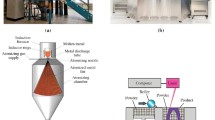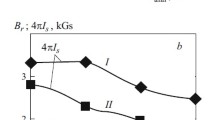The possibility of applying additive technology of selective laser melting for preparing specimens from hard magnetic alloy 25Kh15KA is considered. Melt spraying is used to prepare initial powders for melting with a good yield and adaptability to additive manufacturing. Experimental cylindrical samples with a size of ∅10 × 12 mm and ring magnets with an outer diameter of 46 mm, an inner diameter of 37.8 mm, and a height of 6 mm, are prepared. Microstructures of the specimens are studied and magnetic parameters are measured. Conformity of the properties of magnets produced by additive technology and cast magnets is demonstrated. A novel method of structure multifractal analysis is used to show that synthesized magnets are resistant to external effects.








Similar content being viewed by others
References
A. I. Rudskoi, K. N. Volkov, S. Yu. Kondrat’ev, and Yu. A. Sokolov, Physical Processes and Technology for Preparing Metal Powders from Melts [in Russian], Izd. PSPU, St. Petersburg (2018).
A. Zhukov, B. Barakhtin, I. Shakirov, and V. Bobyr, “The emergence of inhomogeneity in the chemical composition of powder applicable for manufacturing products by additive technologies,” Proc. Manuf., 36, 19 – 25(2019).
T. DebRoy, Huiliang Wei, J. Zuback, et al., “Additive manufacturing of metallic components—process, structure and properties,” Progr. Mater. Sci., 92, 112 – 124(2018.)
D. Herzog, V. Seyda, E.Wycisk, and C. Emmelmann, “Additive manufacturing of metals,” Acta Mater., 117, 371 – 392 (2016.).
P. K. Gokuldoss, J. Eckert, and S. Kolla, “Additive manufacturing processes: Selective laser melting, electron beam melting andbinder jetting-selection guidelines,” Materials, 10(6), 672(2017).
K. V. Wong and A. A. Hernandez, “Review of additive manufacturing,” Mechan. Eng., 4(208760) (2012).
B. K. Barakhtin, A. S, Zhukov, A. A. Deev, and A. V. Voznyuk, “Effect of powder raw material chemical composition on material strength after selective laser melting,” Metalloved. Term. Obrab. Met., No. 6(756), 48 – 52 (2018).
M. Shi, Z. Liu, and T. Zhang, “Effects of metalloid b addition on the glass formation, magnetic and mechanical properties of fepcb bulk metallic glasses,” J. Mater. Sci. Technol., 31(5), 493 – 497 (2015).
K. G. Prashanth, H. Shakur Shahabi, H. Attar, et al., “Production of high strength Al85Nd8Ni5Co2 alloy by selective laser melting,” Additive Manuf., 6, 1 – 5 (2015).
A. B. Baldissera, P. Pavez, P. A. P. Wendhausen, et al., “Additive manufacturing of bonded Nd – Fe – B — Effect of process parameters on magnetic properties,” IEEE Trans. Magn., 53, 2101704 (2017).
F. Yang, X. Zhang, Z. Guo, et al., “3D printing of NdFeB bonded magnets with SrFe12O19 addition,” J. Alloys Comp., 779, 900 – 907 (2019).
M. P. Paranthaman, C. S. Shafer, A. M. Elliott, et al., “Binder jetting: A novel NdFeB bonded magnet fabrication process,” JOM, 69, 1978 – 1982 (2016).
GOST 24897–81. Magnetically Hard Deformable Materials. Grades [in Russian], Izd. Standartov, Moscow ((1981).
B. K. Barakhtin and A. M. Nemets, Metals and Alloys. Analysis and Study. Metal and Alloys Physico-Analytical Research Methods. Nonmetallic Inclusions. Handbook [in Russian], NPO Professional, St. Petersburg (2006).
Y. V. R. K. Prasad and S. Sasidhara, Hot Working Guide: A Compendium of Processing Maps, Russell Township: ASM International (2015).
B. Mandelbrot, The Fractal Geometry of Nature, W. H. Freeman & Company, New York (2002).
A. Hubert and R. Schäfer, Magnetic Domains: The Analysis of Magnetic Microstructures, Springer, New York(1998)
B. A. Barakhtin and V. F. Chashnikov, “Computer program for multifractal analysis of metal and alloys structure images,” Vopr. Materialoved., 4(28), 5 – 8 (2001).
Author information
Authors and Affiliations
Corresponding author
Additional information
Translated from Metallovedenie i Termicheskaya Obrabotka Metallov, No. 5, pp. 36 – 41, May, 2023.
Rights and permissions
Springer Nature or its licensor (e.g. a society or other partner) holds exclusive rights to this article under a publishing agreement with the author(s) or other rightsholder(s); author self-archiving of the accepted manuscript version of this article is solely governed by the terms of such publishing agreement and applicable law.
About this article
Cite this article
Zhukov, A.S., Bobyr’, V.V., Shakirov, I.V. et al. Synthesis of 25Kh15K Permanent Magnets and Study of Their Properties in Service in Magnetic and Thermal Fields. Met Sci Heat Treat 65, 298–303 (2023). https://doi.org/10.1007/s11041-023-00929-8
Received:
Published:
Issue Date:
DOI: https://doi.org/10.1007/s11041-023-00929-8




